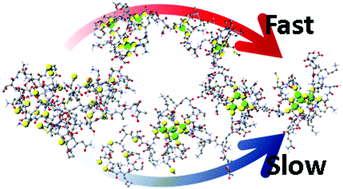Kinetics of competitive Cd2+ binding pathways: the realistic structure of intrinsically disordered, partially metallated metallothioneins†
Abstract
The 20-cysteine mammalian metallothioneins are considered to be central to the homeostatic control of the essential metals Zn(II) and Cu(I) and, as part of their metal-loaded status, play a role in reversing oxidative stress. Native apo-MT does not adopt a well-known structural motif, being described as a random-coil or intrinsically-disordered. Conclusions reached from a combination of ESI-mass spectral charge states, As(III) metallation of apo-MT at low pH, from molecular dynamic calculations and from metallation of the α-domain fragment, suggest that in fact the native apo-MT adopts a structure that is highly efficient towards metallation at physiological pH. The results in this paper show that the initial (M < 5) Cd(II) metallation at physiological pH takes place to form structures based on isolated Cd(SCYS)4 units, beads. At pH 5, cysteine bridged Cd4(SCYS)11 clusters form. ESI-mass spectral profile of cysteine modification of apo-MT at physiological pH shows that it is folded, whereas in the presence of 3 M guandinium hydrochloride the apo-MT is unfolded. Stopped flow kinetic studies of the Cd(II) metallation shows that the reaction is much slower for the unfolded vs. the folded apo-MT for formation of either beads or clusters. Metallation is also much slower for the formation of clusters than the formation of beads. These results are first to quantify the presence of structure in native apo-MT in terms of the critical metallation properties. The implications of this study suggest that oxidation of apo-MT due to ageing or other agent will negatively impact the metallation process for essential metals.



 Please wait while we load your content...
Please wait while we load your content...